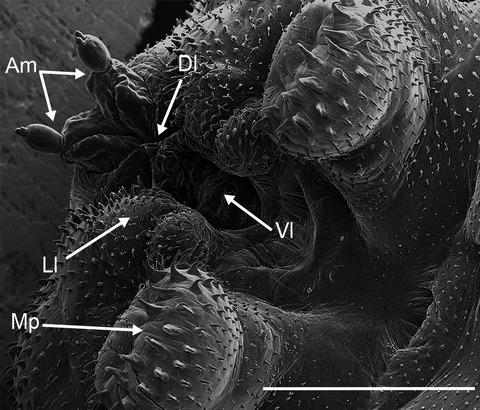当前位置:
X-MOL 学术
›
Entomol. Exp. Appl.
›
论文详情
Our official English website, www.x-mol.net, welcomes your
feedback! (Note: you will need to create a separate account there.)
An in‐depth study of the larval head skeleton and the external feeding structures related with the ingestion of food particles by the eristaline flower flies Eristalis tenax and Eristalinus aeneus
Entomologia Experimentalis et Applicata ( IF 1.4 ) Pub Date : 2020-09-27 , DOI: 10.1111/eea.12974 Andrés Campoy 1 , Andrea Aracil 1 , Celeste Pérez‐Bañón 1 , Santos Rojo 1
Entomologia Experimentalis et Applicata ( IF 1.4 ) Pub Date : 2020-09-27 , DOI: 10.1111/eea.12974 Andrés Campoy 1 , Andrea Aracil 1 , Celeste Pérez‐Bañón 1 , Santos Rojo 1
Affiliation

|
There is an important lack of knowledge regarding the mechanisms and morphology of the structures involved in the feeding process of the bee‐mimicking eristaline flower fly species (Diptera: Syrphidae). In order to look more deeply into their larval feeding biology, a morphological study of the head skeleton and the external feeding structures of the three larval instars of Eristalis tenax (L.) and Eristalinus aeneus (Scopoli), important pollinators and bioindicators of water quality, was carried out, using scanning electron microscopy and confocal laser scanning microscopy. Additionally, an analysis of the ingested particle size was conducted, using various pollen grains and fungal spores. The main differences, found between the third instars of both species, consisted of the more restrictive mandibular lobes of E. tenax, which prevent the ingestion of bigger particles, and a wider filtering area in the cibarium of E. aeneus, which increases the number of particles that can be retained and ingested. Eristalinus aeneus is able to ingest bigger particles (80–100 μm) than E. tenax (70–80 μm). These results suggest that the structures involved in the feeding process of E. aeneus are less restrictive, thus increasing its survival chances when, under artificial rearing conditions, the same medium is used for both species. This study may contribute to the improvement in artificial rearing for future studies on pollination and decomposition.
中文翻译:

Eristalis tenax 和 Eristalinus aeneus 对幼虫头部骨骼和与摄入食物颗粒相关的外部摄食结构的深入研究
关于模仿蜜蜂的 eristaline 花蝇物种(双翅目:Syrphidae)的摄食过程所涉及的结构的机制和形态,严重缺乏知识。为了更深入地了解它们的幼虫摄食生物学,对 Eristalis tenax (L.) 和 Eristalius aeneus (Scopoli) 三个幼虫的头部骨骼和外部摄食结构进行了形态学研究,这些幼虫是重要的传粉媒介和水质生物指标,使用扫描电子显微镜和共聚焦激光扫描显微镜进行。此外,还使用各种花粉粒和真菌孢子对摄入的颗粒大小进行了分析。在两个物种的第三龄之间发现的主要差异包括 E. tenax 的下颌叶限制性更强,这可以防止摄入更大的颗粒,并在 E. aeneus 的 cibarium 中扩大过滤区域,从而增加可以保留和摄入的颗粒数量。Eristalinus aeneus 能够摄取比 E. tenax (70-80 μm) 更大的颗粒 (80-100 μm)。这些结果表明,在人工饲养条件下,两种物种都使用相同的培养基时,埃尼牛的饲养过程中涉及的结构限制性较小,从而增加了其生存机会。该研究可能有助于改进人工饲养,以用于未来的授粉和分解研究。Tenax (70–80 μm)。这些结果表明,在人工饲养条件下,两种物种使用相同的培养基时,埃尼牛的饲养过程中涉及的结构限制性较小,从而增加了其生存机会。该研究可能有助于改进人工饲养,以用于未来的授粉和分解研究。Tenax (70–80 μm)。这些结果表明,在人工饲养条件下,两种物种都使用相同的培养基时,埃尼牛的饲养过程中涉及的结构限制性较小,从而增加了其生存机会。该研究可能有助于改进人工饲养,以用于未来的授粉和分解研究。
更新日期:2020-09-27
中文翻译:

Eristalis tenax 和 Eristalinus aeneus 对幼虫头部骨骼和与摄入食物颗粒相关的外部摄食结构的深入研究
关于模仿蜜蜂的 eristaline 花蝇物种(双翅目:Syrphidae)的摄食过程所涉及的结构的机制和形态,严重缺乏知识。为了更深入地了解它们的幼虫摄食生物学,对 Eristalis tenax (L.) 和 Eristalius aeneus (Scopoli) 三个幼虫的头部骨骼和外部摄食结构进行了形态学研究,这些幼虫是重要的传粉媒介和水质生物指标,使用扫描电子显微镜和共聚焦激光扫描显微镜进行。此外,还使用各种花粉粒和真菌孢子对摄入的颗粒大小进行了分析。在两个物种的第三龄之间发现的主要差异包括 E. tenax 的下颌叶限制性更强,这可以防止摄入更大的颗粒,并在 E. aeneus 的 cibarium 中扩大过滤区域,从而增加可以保留和摄入的颗粒数量。Eristalinus aeneus 能够摄取比 E. tenax (70-80 μm) 更大的颗粒 (80-100 μm)。这些结果表明,在人工饲养条件下,两种物种都使用相同的培养基时,埃尼牛的饲养过程中涉及的结构限制性较小,从而增加了其生存机会。该研究可能有助于改进人工饲养,以用于未来的授粉和分解研究。Tenax (70–80 μm)。这些结果表明,在人工饲养条件下,两种物种使用相同的培养基时,埃尼牛的饲养过程中涉及的结构限制性较小,从而增加了其生存机会。该研究可能有助于改进人工饲养,以用于未来的授粉和分解研究。Tenax (70–80 μm)。这些结果表明,在人工饲养条件下,两种物种都使用相同的培养基时,埃尼牛的饲养过程中涉及的结构限制性较小,从而增加了其生存机会。该研究可能有助于改进人工饲养,以用于未来的授粉和分解研究。










































 京公网安备 11010802027423号
京公网安备 11010802027423号